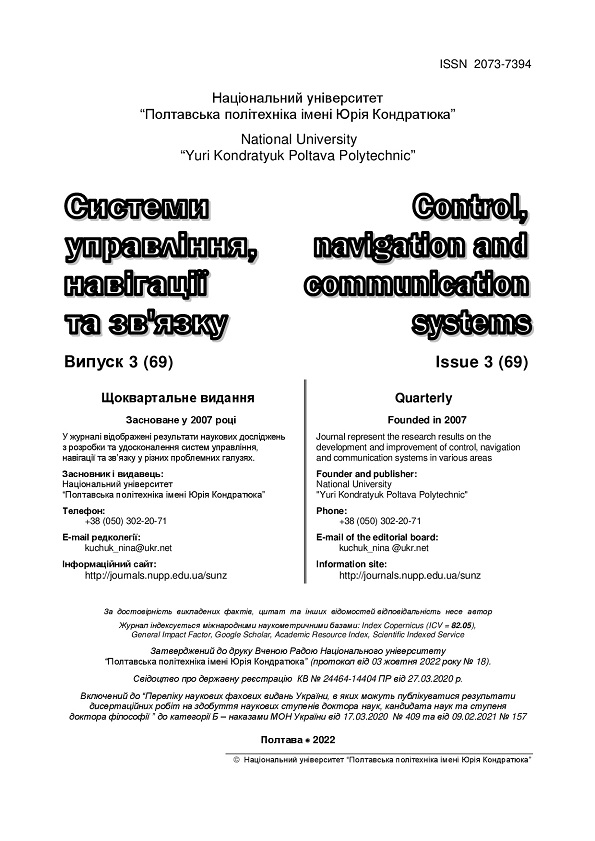INTELLIGENT CONTROL SYSTEM FOR INFOCOMUNICATION NETWORKS
DOI:
https://doi.org/10.26906/SUNZ.2022.3.054Keywords:
network, intellectualization, control system, synthesis, model, requirement, impact, distribution, flowAbstract
The paper studies the conceptual model of an intelligent network, which is proposed to be used in the synthesis of a network for the transmission of control information in intelligent control systems for info communication networks. At the same time, the user of the digital future should be able not only to receive a variety of high-quality services but also to create the necessary services. It is shown that when synthesizing intelligent control systems, the following features should be taken into account: the processing speed at the upper levels of the conceptual model decreases with the growth of "intelligence", which, in turn, decreases as we move down the transport level of the proposed model. The principles of construction and architecture of the intelligent control systems are proposed, taking into account the current readings of measuring and information means. A model for servicing a requirement is proposed, which implies the introduction of determinants of control action and centralized logic. This allows you to speed up and simplify the process of introducing new and correcting existing control actions, which affects the efficiency of the entire network. The model separates service-related aspects from network-related aspects. This allows you to describe the services and capabilities of the intelligent control systems, regardless of the core network over which the intelligent add-on is created. It is shown that one of the effective ways to increase the use of network resources in emergency conditions is the dynamic distribution of information flows. To ensure dynamic flow distribution in the control information transmission network, it is proposed to use a dynamic flow distribution control system, which is a subsystem of the intelligent control systems. The dependences of the probability of choosing a bypass path on the channel utilization factor are analyzed. The average message delay time in the network is analyzed. It is shown that dynamic routing is effective only with average channel utilization. The comparison of dynamic and static distributions of packet streams for uniform load distribution over an absolutely reliable network is carried out. In case of load distortions and/or any damage to the network, the dynamic distribution of packet flows leads to a significantly greater effect.Downloads
References
Tolubko V., Berkman L., Gavrilko E., Barabash O., Kilmeninov O. Development of methods to improve noise immunity in the fifth-generation mobile neworks based on multiposition signals. Eastern-European Journal of Enterprise Technologies. 2018. Vol. 6, No. 9(96). P. 6–16. DOI: https://doi.org/10.15587/1729-4061.2018.152713.
Laptiev O., Shuklin G., Savchenko V., Barabash O., Musienko A., Haidur H. The method of hidden transmitters detection based on the differential transformation model. International Journal of Advanced Trends in Computer Science and Engineering (IJATCSE). 2019. Vol. 8, No 6. P. 2840–2846. DOI: https://doi.org/10.30534/ijatcse/2019/26862019.
Laptev A.A. Barabash O.V., Savchenko V.V., Savchenko V.A., Sobchuk V.V. The method of searching for digital means of illegal reception of information in information systems in the working range of Wi-Fi . International Journal of Advanced Research in Science, Engineering and Technology. 2019. Vol. 6, No. 7. P. 10101 – 10105.
Барабаш О. В., Лаптєв О.А., Свинчук О.В., Соловйов Є.В., Бушков В. Г. Оцінка завадостійкості тракту виявлення радіосигналів. Сучасний захист інформації. 2020. № 1. С 18–24. DOI: https://doi.org/10.31673/2409-7292.2020.011824.
Бреславський В.О., Лаптєв О.А., Правдивий А.М., Зозуля С.А. Розробка алгоритму маршрутизації самоорганізованих радіомереж. Зв'язок. 2020. № 6. С. 54 – 57.
Sezer S., Scott-Hayward S., Chouhan P.K., Fraser B., Lake D., Finnegan J., Vilijoen N., Miller M., Rao N. Are we ready for SDN? Implementation challenges for software-defined networks IEEE Communications Magazine. 2013. Vol. 51, No. 7. P. 36–43.
Gupta R.A., Chow M.-Y. Networked control system: overview and research trends. IEEE Transactions on Industrial Electronics. 2010. Vol. 57, No. 7. P. 2527–2535.
Kirk D.E. Optimal control theory: An introduction. Mineola. New York: Dover, 2004. 452 p.
Mahajan A., Martins N.C., Rotkowitz M.C., Yuksel S. Information structures in optimal decentralized control. 2012 IEEE 51st IEEE Conference on Decision and Control (CDC). 2012. P. 1291–1306.
Lukova-Chuiko, N., Herasymenko, O., Toliupa, S., Laptieva, T., Laptiev, O.The method detection of radio signals by estimating the parameters signals of eversible Gaussian propagation. 2021 IEEE 3rd International Conference on Advanced Trends in Information Theory, ATIT 2021 – Proceedings. 2021. P. 67–70.
Kulin M., Fortuna C., De Poorter E., Deschrijver D., Moerman I. Data-Driven Design of Intelligent Wireless Networks: An Overview and Tutorial. Sensors. 2016. Vol. 16, No. 6. P. 790–796.
Стеклов В. К., Беркман Л. Н., Рудык Л. В., Стец А. С. Система управления сетью связи второго уровня TMN с комбинированным принципом управления. Зв’язок. 2005. № 5. С. 66–69.
Hespanha J. P., Naghshtabrizi P., Xu Y. A Survey of Recent Results in Networked Control Systems. Proceedings of the IEEE. 2007. Vol. 95, No. 1. P. 138–162.
Kibria M. G. et al. Big Data Analytics, Machine Learning, and Artificial Intelligence in Next-Generation Wireless Networks. IEEE Access. 2018. Vol. 6. P. 1284–1291.
Лаптєв О.А., Собчук В.В., Собчук А.В., Лаптєв С.О., Лаптєва Т.О. Удосконалена модель оцінювання економічних витрат на систему захисту інформації в соціальних мережах. Кібербезпека: освіта, наука, техніка. 2021. Т. 4, № 12. С. 19–28.
Memos V. A. Efficient Multimedia Transmission over Scalable IoT Architecture. International Journal of Computer Network and Information Security (IJCNIS). 2018. Vol. 10, No. 6. P. 27–39.
Dolinskiy R. Analysis of system with variable parameters, invariant to additive interference. Eastern-European Journal of Enterprise Technologies. 2015. Vol. 4, No. 4(76). P. 20–24.
Sallai Gy. Defining Infocommunications and Related Terms. Acta Polytechnica Hungarica. 2012. Vol. 9, No. 6. P. 5–15.
Климухин И. А. Основные понятия анализа и синтеза систем автоматического управления. Альманах современной науки и образования. 2012. № 11. С. 82–87.




